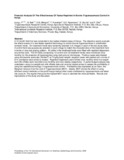Financial Analysis Of The Effectiveness Of Tsetse Repellent In Bovine Trypanosomosis Control In Kenya

View/
Date
2006Author
Irungu, P.
Bett, S.G.
Randolph, T
Nyamwaro, S.O.
Murilla, G.
Olet, P.
Type
ArticleLanguage
enMetadata
Show full item recordAbstract
A 12-month field trial was conducted in two tsetse-infested areas of Kenya. The objective was to evaluate
the effectiveness of a new tsetse repellent technology to control bovine trypanosomosis in smallholder
nomadic herds. Six treatment herds were randomly selected in 6 villages in each of the two study sites.
A control herd was purposively selected in each village to match the characteristics of the treatment herd
in terms of size and grazing pattern. All cattle in the treatment herds were fitted with repellent dispensers
around the neck. The 24 herds (comprising 12 control and 12 treatment herds) were monitored once
monthly for the presence of trypanosomes using dark-ground microscopy. Positive cases were treated
using diminazene aceturate (Veriben®) at 7mg/kg body weight; negative cases with packed cell volume of
21% and below were similarly treated. Repellent dispensers were refilled once monthly while live weight
and milk offtake were recorded once monthly and once weekly respectively. A partial budget analysis was
undertaken using live weight and milk offtake data and nominal market prices to assess the profitability of
using the repellent technology in trypanosomosis control. Profitability was expressed as an index, the
Marginal revenue Over the cost of Trypanosomosis (MOT). Ideally, MOT shows the effect of using
different control methods on the profit margin before other costs unaffected by trypanosomosis are taken
into account. The regime that gives the highest MOT value is deemed the most profitable. Results and
implications of the study are discussed.
Citation
Proceedings of the 11th International Symposium on Veterinary Epidemiology and Economics, 2006Publisher
Department of Agricultural Economics
